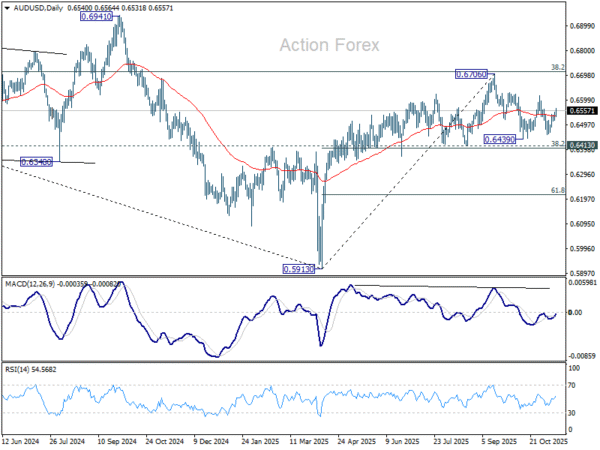Aussie Soars on Strong Jobs Data; U.S. Shutdown Ends, UK GDP in Focus – Action Forex
Australian Dollar strengthened broadly in Asian session today after stronger-than-expected October employment report reinforced confidence in the resilience of Australia’s labor market. The robust job data numbers confirmed that while the labor market is cooling, the adjustment is happening only gradually. The results also vindicated RBA Governor Michele Bullock’s view that September’s weak figures were “just some noise,” rather than the start of a more serious slowdown.
For the RBA, the data reinforce the case for holding rates steady through year-end, giving policymakers time to assess whether inflation would ease back toward target in coming months. Without renewed progress on disinflation, the scope for rate cuts remains limited. February is the earliest opportunity for the RBA to consider easing, though the next move could easily slip to May—or even later—if inflation proves sticky.
In the U.S., the historic government shutdown officially ended after President Donald Trump signed a stopgap funding bill approved by the House in a 222–209 vote. The measure will fund federal operations through the end of January. The Office of Management and Budget instructed federal employees to return to work Thursday. The Department of Transportation also announced it would freeze flight cuts introduced during the shutdown amid air traffic controller shortages.
On the trade front, Swiss Economy Minister Guy Parmelin and State Secretary Helene Budliger Artieda are traveling to Washington to complete talks on a U.S.–Swiss trade deal that could cut the 39% tariff on Swiss exports to 15%, bringing parity with the EU’s rate. Switzerland remains hopeful of sealing the agreement soon, which would benefit key industries including watches, machinery, and chocolate.
In currency markets, the overall picture remains familiar. Yen continues to underperform for the week as the BoJ faces political pressure to delay its long-anticipated rate hike to January at the earliest. The Pound is also soft, with markets firming up bets on a December BoE cut ahead of today’s UK Q3 GDP release.
Meanwhile, the Aussie leads the majors, followed by the Swiss Franc. Though, the latter’s momentum appears to be fading amid “buy the rumor, sell the news” risk ahead of the trade deal announcement. Kiwi holds third place among gainers, while the Loonie and Euro are trading mid-pack.
In Asia, at the time of writing, Nikkei is up 0.25%. Hong Kong HSI is down -0.58%. China Shanghai SSE is up 0.44%. Singapore Strait Times is down -0.006%. Japan 10-year JGB yield is flat at 1.691. Overnight, DOW rose 0.68%. S&P 500 rose 0.06%. NASDAQ fell -0.26%. 10-year yield fell -0.055 to 4.065.
Australia jobs surge 42.2k in October as unemployment rate falls to 4.3%
Australia’s labor market showed renewed strength in October, with employment rising by 42.2k, more than double market expectations of 20.3k. The gain was driven by a 55.3k surge in full-time positions, partly offset by a -13.1k drop in part-time work, highlighting a solid expansion in higher-quality jobs.
The unemployment rate unexpectedly fell from 4.5% to 4.3%, beating forecasts of 4.4%, while the participation rate held steady at 67.0%. Meanwhile, monthly hours worked climbed 0.5% mom, further underscoring the underlying resilience of labor demand.
The upbeat figures reaffirm Australia’s labor market resilience and encourage the RBA to maintain its current cautious tone rather than pivot quickly toward easing. With inflation pressures lingering and employment holding firm, the RBA is likely to wait for clearer signs of slack before signaling rate cuts—keeping February as the earliest plausible window for policy adjustment.
BoJ’s Ueda highlights tight job market, resilient consumption
BoJ Governor Kazuo Ueda told parliament today that Japan’s inflation is gradually aligning with the central bank’s 2% goal, supported by improving wages and steady domestic demand. He reiterated the BoJ aims for moderate inflation accompanied by rising incomes and economic improvement, rather than price gains driven solely by import costs or temporary shocks.
Ueda noted that while demand for food and other non-durable goods has softened, household consumption remains resilient thanks to higher incomes and a tight labor market. He highlighted that stronger wage growth is helping sustain a moderate cycle of rising prices and pay—an essential precondition for durable inflation in the BoJ’s framework.
He added that underlying inflation—stripping out volatile components—is gradually accelerating toward the 2% target, driven not only by food but also by price increases across a broader range of goods and services.
“When we look at underlying inflation that strips away temporary factors, it is gradually accelerating toward our 2% target,” he said.
Japan CGPI rises 2.7% yoy in October, weak yen fails to lift import prices
Japan’s Corporate Goods Price Index rose 2.7% yoy in October, easing slightly from 2.8% in September but exceeding expectations of 2.5%, according to Bank of Japan data.
Notably, the Yen-based import price index fell -1.5% from a year earlier, marking its ninth straight month of decline. The persistent drop indicates that the weak Yen is not translating into renewed cost-push inflation—contradicting the typical currency-inflation link.
AUD/USD Daily Report
Daily Pivots: (S1) 0.6521; (P) 0.6535; (R1) 0.6555; More...
AUD/USD’s rebound from 0.6457 extended higher today, but it stays below 0.6616 resistance. Intraday bias remains neutral at this point. On the downside, break of 0.6457 will target 0.6413 cluster (38.2% retracement of 0.5913 to 0.6706 at 0.6403). Decisive break there will carry larger bearish implications. On the upside, break of 0.6616 will bring retest of 0.6706 high instead.
In the bigger picture, there is no clear sign that down trend from 0.8006 (2021 high) has completed. Rebound from 0.5913 is seen as a corrective move. Outlook will remain bearish as long as 38.2% retracement of 0.8006 to 0.5913 at 0.6713 holds. Break of 0.6413 support will suggest rejection by 0.6713 and solidify this bearish case. Nevertheless, considering bullish convergence condition in W MACD, sustained break of 0.6713 will be a strong sign of bullish trend reversal, and pave the way to 0.6941 structural resistance for confirmation.


